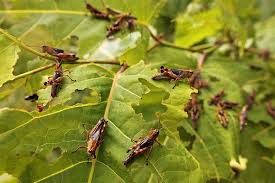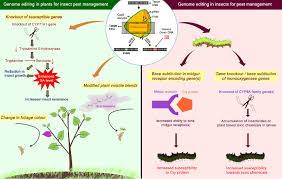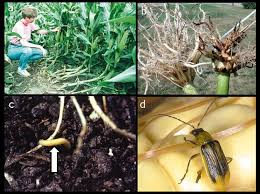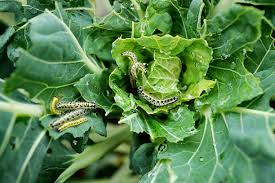As well as losses to crops caused by diseases, animals such as insects and nematodes are significant biotic factors. There are two basic types of feeding behaviour by insect pests. Some pests, such as aphids, leafhoppers, and whitefly, obtain their food by piercing plant cells with their mouthparts and then sucking out the cell contents. Such insects often live in large colonies and cause damage not only by killing plant cells but also as major vectors of plant viruses.
The other type of insect feeding behaviour is chewing plant leaves, stems, or other parts of the plant. Most of these insects are beetles (Coleoptera), flies (Diptera), or moths (Lepidoptera) and, in most cases, it is the larvae that do the damage.
Insects feed on seeds or on the inside of the plant stem; the feeding damage on seeds can lead to fungal infection and thus to mycotoxin production.
The larvae of insects feed on the inside of cotton fruiting structures (cotton bolls from which cotton is extracted), causing considerable economic losses; losses are more considerable in developing countries where less insecticides are used.
Read Also: Feijoas: History, Nutrition, Health Benefits and Growing Guide
Approaches to Controlling Insect Pests in Agriculture

There are four basic approaches to controlling pest insects. The most widespread method is the application of insecticides, which causes many problems. As well as the potential hazard to human health, most insecticides are not completely specific to the target pest, also killing non-target beneficial insects; they can enter the food chain causing hazards to birds and mammals.
Furthermore, it is difficult to control pests that feed inside plants, such as stem borers, with insecticides. The continual use of insecticides can lead to the target insects developing resistance to the chemical.
As with plant pathogens, farmers adopt a range of cultural techniques to try to control insect predation. Attempts to avoid insects are made by planting crops at times or in places where insect populations are minimal. Mixed cropping can reduce insect populations; for instance, some Andean farmers grow maize and lupins together, which reduces insect damage on the corn.
Mixed cropping leads onto another approach to pest insect control, that of integrated pest management (IPM). There have been many IPM schemes, but relatively few can be regarded as being entirely successful.
This is because of the complexity of the ecosystems that the schemes are attempting to influence and the fact that there are many varying external factors continuously affecting the ecosystems.
Fourthly, as with controlling pathogens, plant breeding has been extensively used in attempts to introduce characters conferring resistance to pest insects into crop plants. Since plants cannot run away from danger, they have developed three types of defence against insects and other herbivores.
Plant secondary metabolites have been adapted to either poison or deter pests to give effectively internal chemical control. However, as many of these may cause damage to humans, they have to be reduced or eliminated over the years in breeding programmes.
The structure of plants can provide physical barriers that inhibit pest insects, and plants can grow in such a way as to compensate for damage caused by pests. Examples of this are hairy leaves or leaves with glands that exude a sticky liquid.
Genetic Modification for Controlling Insect Pests

One of the two transgenic traits that have been commercially deployed in a widespread manner is that conferring protection against certain insect pests. There are two main modes of operation of these transgenes.
The most frequently used is that which inhibits the insects’ digestion processes, either by damaging the gut wall or by inhibiting digestion, thereby starving it.
There are two genes used to damage insect pest gut walls, the most widespread being the toxin encoded by a bacterium named Bacillus thuringiensis, termed Bt toxin.
The basic details of Bt and its endotoxin are shown. There are different forms of the Bt toxin protein, each with a different range of target insects. It is important to note that most of these target insects are those that chew plants and usually not those that feed by piercing and sucking.
Another important point is that each toxin is limited in its effective range and is not toxic to most non-target organisms. Recently, studies have shown that it is possible to modify the Bt toxin molecule to change its target and tailor it to specific requirements.
The transgenic expression of the Bt gene means that the toxin is produced throughout the plant and is very effective against pests that live within the stem or in cotton bolls; thus, transgenic expression of Bt gives good levels of pest control in commercially released varieties. It is now being considered for controlling pests in food crops such as rice.
Benefits and Concerns of Bt Crop Deployment In Agriculture
The widespread deployment of Bt toxin-expressing crops has revealed various advantages and also raised a number of concerns. Among the advantages are greatly increased yields, reduced insecticide input, and a reduction in the production of mycotoxins. The concerns fall under four headings:
1. Possible effects to the health of humans and other animals* have been studied in depth, and, in spite of various reports, there is no firm evidence for any bad effect.
2. There have been concerns about gene flow to the environment* – these will be considered later.
3. Similarly, there have been concerns about effects on non-target species* exemplified in the Monarch Butterfly episode. Once again, there is no direct evidence for such effects, especially when one measures them against a baseline of the conventional agronomic practice of insecticide spraying.
4. There are worries about target insects developing resistance against Bt toxin,* and there is some recent evidence that this may be happening in limited cases. Ways of mitigating this will also be discussed in Article 5.
Alternative Genetic Approaches to Insect Control in Agriculture
The second gene used to affect the insect’s digestive system is an agglutinin from the snowdrop (Galanthus nivalis) (GNA), which targets sap-sucking insects. Although the transgenic expression of GNA shows considerable promise in controlling several important plant pests, there have been no commercial releases on it yet.
Concerns have been expressed as to potential hazards to human health, and its use has been controversial: for the so-called Pusztai GNA-potato controversy. In view of the “bad press” concerning GNA, the possibilities of using other plant lectins are being explored.
As well as affecting digestion by damaging or blocking the insect gut cell wall, the actual process of digestion can be inhibited. Insects use various enzymes to digest their food in their gut such as proteases that digest proteins.
There are various forms of proteases, the most important ones in insects being trypsins, chymotrypsin, alpha-amylase, and cysteine; inhibitors for each of them are known.
Experiments are under way to express these protease inhibitors in plants so that insects feeding on them cannot digest their food. The concerns about protease inhibitors are similar to those on Bt toxin and especially on possible effects on non-target species.
Experimental Strategies for Future Insect Control in Agriculture
Various other approaches to protecting crop plants against pest insects are being explored. These include the isopentenyl transferase gene from bacteria which affects insect cytokinin biosynthesis, toxins from spiders, scorpions, and wasps, and proteins from insect endoparasites.
All these are at the experimental stage and after assessing their effectiveness, large-scale safety checks have to be undertaken. Also, they will have to be acceptable to the public, and some of the toxins mentioned above may prove difficult to “sell”.
However, it is possible that some of these genes or yet others may reach the stage of commercial release reasonably soon.
Read Also: Pawpaws: History, Nutrition, Health Benefits and Growing Guide
Application of Transgenic Insects in Agricultural Pest Control

The application of gene technology to arthropods is not as advanced as that to crop plants but there are various research programmes in this area that are beginning to lead to products for which biosafety issues will have to be considered.
There are several breeding programmes for both the enhancement of beneficial insects and for producing material for pest control approaches.
For instance, silkworms have been bred for many years to improve stock and there are breeding programmes for developing resistance of bees to diseases and pests and other characters. Pest resistance traits can be introduced into arthropods that are used for biological control.
A major way of controlling pest insects is by introducing sterile males into the natural population; this is termed the sterile insect release method (SIRM). This has been used mainly for pests of animals and for animal disease vectors but has equal applicability to some plant pests.
In this method, large numbers of males are rendered sterile by irradiation and compete with the natural fertile males. However, the method has various problems, one of the main ones being obtaining insect populations that are primarily male. The application of recombinant DNA technology to make the population predominantly male would help in overcoming these problems.
Genetically Modified Arthropods for Agricultural Use
As noted above, there are various research programmes aimed at genetically modifying insects. These include improving beneficial insects, conferring pesticide resistance onto biocontrol insects, improving insect viruses for insect control, producing mainly male progeny for SIRM, providing molecular markers to distinguish sterile from wild insects, and making disease vectors unable to transmit diseases.
Do you have any questions, suggestions, or contributions? If so, please feel free to use the comment box below to share your thoughts. We also encourage you to kindly share this information with others who might benefit from it. Since we can’t reach everyone at once, we truly appreciate your help in spreading the word. Thank you so much for your support and for sharing!

